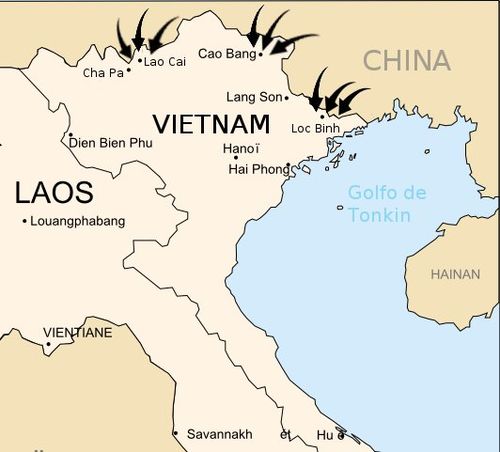Sino-Vietnamese war
| Sino-Vietnamese War | |||||||
|---|---|---|---|---|---|---|---|
| Part of Third Indochina war and Sino-Soviet split | |||||||
 Map of the Sino-Vietnamese Wars, showing major Chinese incursions. | |||||||
| |||||||
| Belligerents | |||||||
|
|
| ||||||
| Strength | |||||||
|
Chinese claim: 200,000 soldiers Vietnamese claim: 600,000 soldiers |
70,000-100,000 soldiers 150,000 militia | ||||||
The Sino-Vietnamese War was a short-lived conflict[note 1] in early 1979 between the People's Republic of China and the Socialist Republic of Vietnam. This conflict was a response to the Vietnamese invasion and occupation of Cambodia led by the China-backed Khmer Rouge. In February 1979, China under Deng Xiaoping launched a surprise invasion of northern Vietnam, capturing several cities near the borders. On March 6th 1979 China declared their mission successful, as they forced Vietnam to back some forces out of Cambodia to go protect Hanoi. However, the Vietnamese occupation of Cambodia continued all the way into 1989 and Vietnam was able to oust Pol Pot out of Cambodia. Sino-Vietnamese relations weren not fully restored until 1991. China was trying to prove that the USSR was unable to protect its allies.
Background
Sino-Soviet Split
China and Vietnam have a long history. During the first Indochina war with France, China continued the mission of USSR to spread communism, therefore they aided Vietnam and acted as a mediator between between the USSR and Vietnam.
After the death of Joseph Stalin, Sino-Soviet relations began to fall apart. Mao Zedong believed that Nikita Khrushchev fell into a revisionist direction antagonistic to Marxism–Leninism, and that he made a massive error denouncing Stalin in his secret speech. This led to the Sino-Soviet Split which then led to the lowering aid from China to Vietnam, because they did not support the PRC against the USSR.
In response to this falling apart, as many as a million Chinese troops were stationed along the Sino-Soviet border, getting ready for a full-scale war.
At the same time Vietnam was further distancing themselves from China by Increasing its alignment with the USSR and joining Comecon (Council for Mutual Economic Assistance)
Following the death of Mao and the overthrow of the Gang of Four and the rise of Deng Xiaoping, China revised their economy to be market oriented, denounced the Cultural Revolution, and collaborated with USA against USSR.
Vietnam War
As France withdrew from Vietnam, and America started stepping in to support South Vietnam, the USSR and Vietnam became important allies. For the PRC this was a disturbing development, because it would mean they could find themselves encircled in the Soviet sphere of influence.
After the US withdrew their forces from Vietnam and the rest of Indochina completely, the Democratic Republic of Vietnam (or North Vietnam) invaded the South and quickly overwhelmed the dependent regime, liberating that region. The PRC started talks with the US (specifically with Henry Kissinger and later Richard Nixon) which would see their foreign policy be re-oriented towards USA
References
Notes
- ↑ It lasted 3 weeks and 6 days.